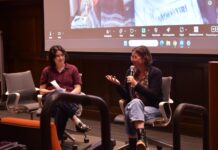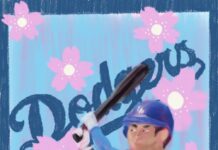Author: Kelly Neukom
Cartoonist Lela Lee, creator of the “Angry Little Girls” comic strip, came to Oxy to speak on April 8. Although she had been to the campus once before for a filming as an actress for the TV show Charmed, this was her first time here as a speaker. Her visit was part of Asian Pacific Islander Heritage Week.
Lee, a Korean, grew up in San Dimas, a “small, sleepy whitewashed neighborhood” in LA. There were so few minorities in her class that many of her classmates didn’t know where Korea was.
“I couldn’t fit in with my class, but my parents wanted me to assimilate and blend in,” Lee said. “Whenever I complained to them, all they said was, ‘Oh, just be nice!’ I grew up frustrated and unable to articulate my frustration.”
Her cultural background also discouraged women from talking back. “[Korean] girls are supposed to be obedient, sacrificial and compliant,” she said.
Lee began her career as an artist in 1994, when she was a sophomore at UC Berkeley. The university “ripped her brain apart,” she said, and the frustration of being a female finally got to her. Lee went to the Sick and Twisted Festival of Animation and became incredibly offended by it instead of finding it funny. So with her friend’s encouragement, she made a video titled “Angry Little Asian Girl, First Day of School.”
“I thought back to experiences I had when I was younger,” she said. “Someone had said something really mean to me and I wish I had said this . . . so I did. When I finished, I thought, ‘Wow, that is just so angry-I’ve got to hide it.'”
So she hid the film in her drawer for a few years while she worked at her parents’ dry-cleaning business. She finally took the video out of the drawer and made four other episodes. A friend who worked at a movie theater offered to play them before a feature movie and the reviews in the LA Times and LA Weekly gave more praise to her five shorts than the film that came after them.
“I thought, ‘Wow, I’ve really hit on something,'” Lee said. She decided to make 300 t-shirts with her drawings on them, even though she said she didn’t even know 300 people. She would take a card table and a cash box to crowded places and try to sell them to passersby. “I interacted with lots of people,” Lee said. “Even people who weren’t Asian connected with the drawings because they understood what it was like to be underestimated.”
She eventually expanded her strips to feature many different characters (girls and boys) and created dozens of strips with the characters interacting. The strips (many of which she read out to the audience) addressed issues from rocky relationships with parents to angry outbursts at boyfriends.
Although she tried to draw a syndicated comic for newspapers, she kept getting rejection letters and realized she had to “stop trying to do it for [the newspapers] and to fit into their little square boxes,” she said. She finally found a small company to publish her strips in books. Lee’s first book came out in April 2005 and with no marketing at all, it was on its fourth printing by that June.
Her fifth book will be released June 2009, which is about love. “I really love this one,” she said. “I feel like I’m getting away with something. It makes me snicker and feel good.”
Although the strip started out mostly confronting racism, Lee doesn’t focus on that topic as much anymore. “It was an outburst at the beginning because it was dammed up inside of me,” she said. “Now there are so many other topics I want to address-so much more for the characters to experience.”
Lee’s advice for students who wish to become artists was simple and to-the-point: “Don’t ask for permission.”
This article has been archived, for more requests please contact us via the support system.
![]()




































